mobile View, to the German Version tap the flag


- Democratic Republic of East Timor
- presidial republic
- own names:
– Portuguese: Timor Leste
– Tetum: Timor Loro Sa'e
– Indonesian: Timor Timur
- · to 1976 Portuguese colony
· to 1999 Indonesian province
· since 20th of May 2002 independent
• Flag
• Historical Flags
• Meaning/Origin of the Flag
• Coat of Arms
• Meaning/Origin of the Coat of Arms
• Map
• Numbers and Facts
• History
• Origin of the Country's Name
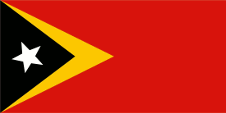
National, state and merchant flag,
ratio = 1:2,
Source, by: Flags of the World





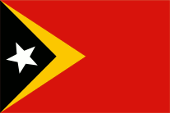
Variant in differing proportions,
ratio = 2:3,
Source, by: Flags of the World




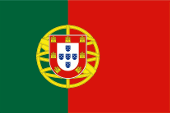
1911–1976,
National flag of Portugal,
ratio = 2:3,
Source, by: Corel Draw 4





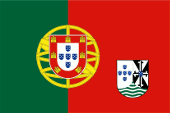
Sixties of the 19th cent.,
purposed flag for Portuguese Timor,
ratio = 2:3,
Source, by: Wikipedia (DE)



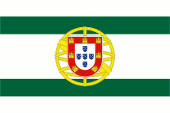
to 1935,
Flag of a High Commissioner,
ratio = 2:3,
Source, by: Flaggenbuch 1939



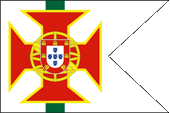
1935–1961,
Flag of a District Commandant,
ratio = 2:3,
Source, by: Flaggenbuch 1939



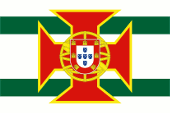
1935–1975,
Flag of the Governor General,
ratio = 2:3,
Source, by: Die Welt im bunten Flaggenbild



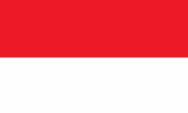
1975–1999,
East Timor belongs to Indonesia,
National, merchant and naval flag of Indonesia,
ratio = 3:5,
Source, by: Flaggen und Wappen





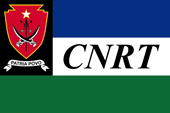
1998–2001,
Flag of CNRT,
ratio = 2:3,
Source, by: Wikipedia (DE)



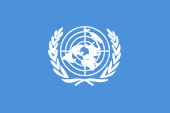
1999–2002,
East Timor is administered by the UN,
ratio = 2:3,
Source, by: Wikipedia (EN)






The today’s flag of East Timor is exactly the same flag like it was adoped in context with the declaration of independence on the 28th of November in 1975. It was officially re-introduced on the 20th of May in 2002 and shows a single-coloured red bunting, as well as on the pole two on top of each other lying down isosceles triangles. Below a golden triangle as wide as the half of the length of the flag and above a black triangle as wide as a third of the length of the flag. In the black triangle is placed a white five-pointed star which points with its upper point in the direction of the upper left corner of the flag. The appearance of the flag was last specified in the constitution of the country, in Part I Section 15, in 2002. The proportions are described as 1:2. The white star shall point with its upper point to the upper left corner of the flag. The colours are not precisely defined, only as "yellow" and "red" which over time has become Pantone 123 for yellow and Pantone 485 for red. In practice, however, several variants of the flag can be found, with different light or dark shades of yellow and red, with different proportions (mostly 2:3) or with a straight placed star. When the flag was created in 1975, the colours had the following meanings: black stood for the long period of colonial oppression, white for hope for a better future, red for the blood spilled in the struggle for freedom and yellow for the fight for independence. According to the 2002 constitution, black represents the great unknown and the doubt that must be overcome, white represents peace, gold represents the wealth of the country and red symbolises the struggle for freedom. In the times of the Portugese colony was solely in use the Portugese national flag because they saw the colonies as permanent component of the motherland and not as outer possessions. This implys that Portugese colonies never had own flags, even if there were ambitions in the sixties of the 20th century to introduce flags for the colonies by placing of the coat of arms of the colony in the flying end of the Portugese national flag. But this plans became never realized. In the year 1935 own coats of arms were created for the Portuguese colonies. The design was subject to a special scheme. So each coat of arms contained, in addition to a local symbolism, the five Quinas from the coat of arms of Portugal and five green waves on silver. As a local symbolism, a silver and black lily cross appeared on the coat of arms of East Timor, on a in the same colours divided field.
Source:
Flags of the World,
Wikipedia (EN),
Volker Preuß

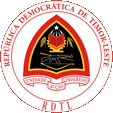
since 2007,
Coat of arms of East Timor,
Source: en:User:Vino4u,
Public domain, via Wikimedia Commons
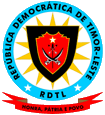
2002–2007,
Coat of arms of East Timor,
Source: Jam123, CC0, via Wikimedia Commons

1935–1976,
Coat of arms of Portuguese Timor,
Source: Wikipedia (D)

The current coat of arms of East Timor was adopted on 18th of January in 2007 and goes back to a coat of arms used by the resistance during the Indonesian occupation. It symbolises the globe and on it the country of East Timor. The coat of arms shows the silhouette of Mount Tatamailau in black with a yellow-red border, within it a white five-pointed white star, a red open book, in front of a golden yellow cogwheel, between two golden ears of rice, below a Kalashnikov crossed with a golden Timorese spear (Diman), above a golden Timorese bow (Rama-inan). The white banner below the mountain shows in red letters the Portuguese words: "Unidade, Acção, Progresso" → "Unity, Movement, Progress". The red-edged white ring around the outside shows the name of the country in Portuguese at the top and the abbreviation "RDTL" at the bottom. The previously used coat of arms was officially adopted on 20th of May in 2002. It was more like a seal and showed within a pale blue ring which carryed the name of the state a golden star with 14 points. The number 14 was probably a hint to the number of the in the CNRM (from 1998: CNRT) – a kind of parent organization of all anti-Indonesian resistance groups – joined organizations. On the star was positioned a black-red shield with various weapons and a white star. This shield is the symbol of the CNRM. One of this CNRM groups was the FALINTIL. Its Motto became the motto of the state represented in the red banner below the shield: "HONRA, PÁTRIA E POVO" → "Honor, Fatherland and Nation"
Source:
Wikipedia (DE),
Volker Preuß

Location:
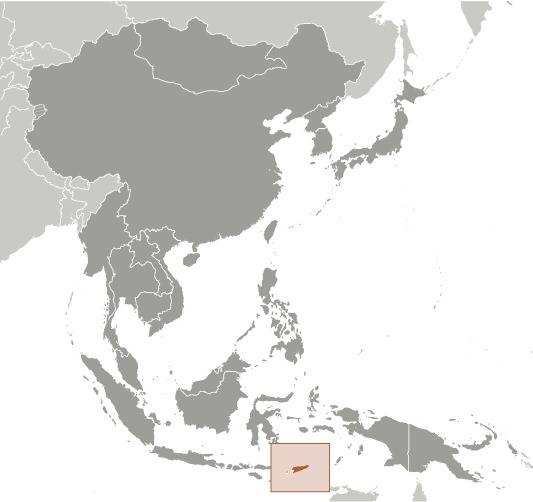
Source: CIA World Factbook
Map of the country:
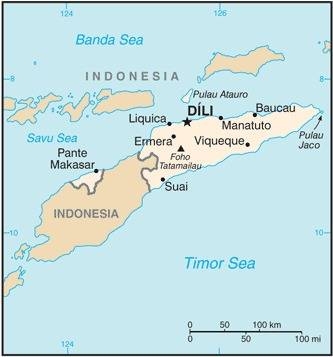
Source: CIA World Factbook

Area: 5.760 square miles, thereof Exclave of Oecusse Ambeno 314 sq.mi., Autaúro Island 54 sq.mi., Jaco Island 3 sq.mi. (uninhabited)
Inhabitants: 1.340.434 (2022), thereof ca. 75 % Austronesian (Malayo-Polynesian: Tetun, Mambai, Tokodede, Galoli, Kemak, Baikeno), ca. 25 % Melanesian-Papuan (Bunak, Fataluku, Bakasai), small Chinese minority
Religions: 97% Roman Catholic, 2% Protestant
Density of Population: 232 inh./sq.mi.
Capital: Dili, 310.600 inh. (2022)
official Languages: Portuguese, Tetum (Pidgin language)
other Languages: English, Bahasa Indonesia (Indonesian)
Currency: 1 US-Dollar (US$) = 100 Timor Centavo
Time Zone: GMT + 9 h
Source: Wikipedia (D)

The colonialization of Timor Island was powered by Portugal
since the beginning of the 16th century. In the year 1586
was officially established the Colony of Portuguese Timor, however in 1688
the Netherlands appropriated the
western part of the island. In 1895 the island was formally partitioned
between Portugal and the Netherlands. Between 1942 and 1945 it was in
passing occupied by Japan. After
the withdrawal of the Japanese the colonial administration was restored also
in the eastern part of the island. Against the Portuguese administration
started sporadical armed resistance. On 11th of June in 1951 Portugal
declared its Colony of Portuguese Timor to an overseas province and in 1972
even to an autonomous region. After the collapse of the military government
in Portugal in April of the year 1974 started in East Timor armed quarrels
in the struggle for the political predominance after the foreseeable end of
the Portuguese colonial rule. On the one side the "Revolutionar Front for the
independence of East Timor" (FRETILIN), on the other side the "Democratic
Union of Timor" (UDT) and the "Democratic People's Association of Timor"
(APODETI); one like the other political groups which aimed for the annexion
by Indonesia. The FRETILIN brought nearly the whole area of the territory of
East Timor under its control and proclaimed on 28th of November in 1975 the
“Democratic People’s Republic of East Timor”. The pro-Indonesian groups
declared one day later (29th of November 1975) the union of East Timor with
Indonesia. On 7th of December in
1975 intervened regular Indonesian troops in the civil war and occupied East
Timor. The pro-Indonesian groups established on the 17th of December in 1975
a provisional government. The UNO demanded the withdrawal of the Indonesian
troops, but Indonesia incorporated East Timor per statute from the 17th of
July in 1976 as 27th province into the Indonesian sovereign territory.
Portugal informed the UNO in April of 1977 that it since August 1976 no
longer performed the effective sovereignty over its colony and that it not
recognizes the forcible annexation by Indonesia. The UNO confirmed by
resolutions in the years 1977, 1978 and 1979 the right of the people of East
Timor for sovereignty and independence as well as its legitimation to fight
for those. The FRETILIN, the FALINTIL and other groups continued the armed
struggle against the Indonesian garrisons, again and again there were mass
protests of the people. In the capital Dili there was happen on 12th of
November in 1991 the so named "Santa Cruz Massacre" following an mass
demonstration. Here were murdered at least 100.000 of East Timorese on the
terrain of a cemetary. After riotings the people of East Timor achieved in
context with a change of government in Indonesia in the year 1999 – end of
the era of President Suharto – the official execution of a referendum about
the full independence from Indonesia or autonomy within the Indonesian
state. President Habibi – the successor of Suharto – recognized and
respected the referendum, which endet with 80% for the independence of East
Timor. Janana Guzmão – the Leader of the FRETILIN – became released. After
that pro-Indonesian militia coated the country supported by the Indonesian
Army with a wave of terror in which died ca. 1.000 East Timorese in August
and September 1999. On the 20th of September in 1999 finally debarked UNO
troops in Dili to finish the terror. The Indonesian Parliament now
officially recognized the independence of East Timor from Indonesia. But the
fight against the terror of the militia continued. Because of that East
Timor could not get immediately its full sovereignty and was in passing
administered by the UNO. East Timor achieved the full independence on the
20th of May in 2002. First free elected president of the country became
Janana Guzmão. The struggle for independence of the East Timorese against
Indonesia between 1976 and 2002 costed ca. 250.000 people's life.
Source:
UNPO,
Wikipedia (DE),
Volker Preuß

The name of "Timor" Island descends from the Malaysian language and means "East". In this way is described the geographical position of the island eastern of the main island Java. "East" in the significance of "East"-Timor means in Portuguese "Leste", in Tetum "Loro Sa'e" and in Bahasa Indonesia (Indonesian) "Timur". From that come the names of the country: "Timor Leste", "Timor Loro Sa'e", "Timor Timur".
Source:
Wikipedia (DE),
Volker Preuß


![]()
























